Summary:
It is an activity that focuses on the decision-making process on the construction of a project of great environmental impact. It is intended that students learn to make well-informed decisions, more responsible and more appropriate to the Latin American reality, with the observance of the many variables involved, such as vulnerability and environmental legal responsibility of companies, government and banks involved. To this end, they assume different roles to seek a consensual solution to a case involving the construction of the Jirau and Santo Antônio Hydroelectric Power Plants in the Amazon region of the north.
Objective:
- GENERAL GOALS: to take a schedule for taking public and private decisions involving climate change made by the Global Sul, especially in Latin America, with specific questions on the context of these countries (example: vulnerability, weak state presence.); - SPECIFIC GOALS: to make participants reflect, from a concrete case, about the variables that are involved in decision-making involving the construction of large projects in Latin America (vulnerability, environmental objective responsibility in Brazil, jurisprudential trends, belief in economic development as a way to mitigate the social problems, speed in decision making, political pressure, impact on people affected positively and negatively by the project, indigenous issues, contracts elaboration, etc. - The aim is to develop in the students the ability to make better and more responsible decisions to address climate problems, whether in the public sector through public policies (adaptation to contingencies caused by climate change) or in the private sector. It also aims to develop the ability to negotiate and reach consensus.
Dynamics:
- TEACHING METHOD: the role-playing method, in which students take a clear role for solving a concrete case; - REQUIREMENTS: there was no previous mandatory reading. Nothing prevents students that have previously read the case and a bibliography of support; - INTRODUCTION TO THE DYNAMICS: It began with the presentation of the video "Damocracy" (link: https://www.youtube.com/watch?v=IQFpohbSxYg) about the impacts of the construction of hydroelectric power plants of Belo Monte in Brazil, and Ilisu in Turkey in order to show the impact with the start of construction of dams in the surrounding communities. Then, it was presented the scenario of construction of the power plants in Rio Madeira. It was, hypothetically, the moment that the class had the decision-making time about whether a private bank would finance part of the project, which had already had their preliminary environmental license granted by IBAMA or not. From the reading of the case, the participants had to assume the role of investors who owned banks enterprises funding targets in South America, but should also consider the other variables involved in the operation. For this, they gave to students the Equator Principles, which are voluntarily adopted by banks and establish minimum criteria for environmental sustainability to be followed for the granting of credit, the legal provisions about environmental legal liability and judged people in the Supreme Court who dealing the responsibility of the banks;
- DEVELOPMENT OF THE DYNAMICS: Following this, the participants gathered in groups to discuss whether they invested or not in a venture like the power plant of Jirau and Santo Antônio, and in the end of a the time for debates, they should write a short essay stating your opinion. The professor took the mediating position and added some elements to the discussion as the exercise was being developed (example: new facts arising after the problem, new problems, new demands, etc.). She fostered the debate for participants to discuss what was relevant to a decision taken in the context of a country of Global Sul, which could be discarded, what role the investor should have (if the bank should be engine of development for example), what answers they should give to legal problems that might face, resuming, what are the core issues in the decision-making process in the country of Global Sul;
- END OF THE DYNAMICS: the professor required the participants that they enter into a consensus on what decision they would make. Thus, she put on trading people who had divergent positions and demanded that they take the same decision. If participants did not reach a single decision, a single consensus, the professor encouraged the students to arrive at a consensus on what should be necessarily taken into account the decision taken in Latin America (common minimum at all). That is because if the professor could not reach any consensus, it would be anti-pedagogic and would not achieve the objectives of the exercise. In the end, the professor highlighted the main points of the decision and presented to the participants what they took into account in the decision-making process. In conclusion, it gives an overview of the lawsuits that have been brought challenging the control of impacts and responsibility of the actors involved in the construction of hydroelectric power plants in Brazil, in order to show how the question has been placed on the Brazilian judiciary.
Evaluation:
- FEEDBACK: It was important to make clear to students the skills that are intended to be developed with the case and that it would be presented to their return (feedback) about how they played their part;
- GRADE EVALUATION: there was no evaluation. It would be possible to evaluate a grade of participation - preparation, participation - and a delivery of a written decision. The grade could be higher conforming the participation and decision writing have more content and show that the student has taken the decision considering the variables involved.
Observation:
- The exercise was applied to the activity in the I Symposium and Workshop about Climate Change and Decision Making, organized by the Regional Center of Climate Change and Decision Making, within UNESCO, and it has been selected for the Environmental Law class of the Professional Master’s degree of DireitoGV (2013);
- Considering the complexity of the case, its context could be explored in the course of a semester, which would be positive also in the sense that students would be better able to take possession of all the elements and related information.
- In larger classes, you can make the participants take the position of different actors (NGOs, government, etc.)
Copyright from the cover page image from the Active Legal Education Materials Database:
Image: "Srisailam Dam with Crust Gates Open", of 2007, available by the Wikimedia Commons user "Chintohere", under a public domain license.





